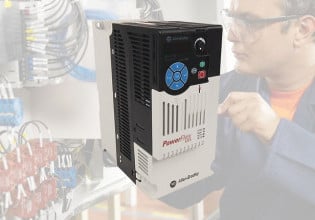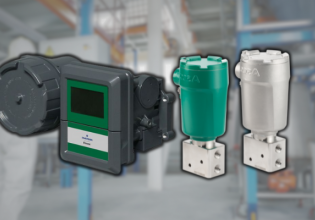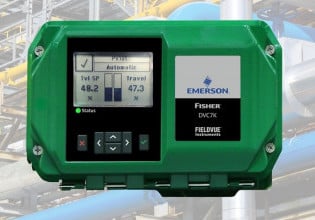Wood You Look at That? The Incredible Automation Controlling Lumber Mills
From forest to felling, logging road to mill, finished lumber’s adventure on its way to market is filled with control and automation. Learn about the process from start to finish and how lumber mills ensure the world has access to high-quality lumber thanks to control technology.
Three things in life are certain: death, taxes, and repeat trips to the hardware store... regardless of the project you’re working on! Did you ever wonder how all those supplies, especially that dimensional lumber, got there in the first place?
Lumber Production: Automation from Timber to Mill
Recently, I visited a lumber mill located in the small logging town of Morton, Washington, about two hours from Seattle or Portland. Operated by Hampton Lumber, the busy mill produces boards from fir trees harvested around the Pacific Northwest.

Figure 1. The automation that turns logs into lumber is amazing!
Producing dimensional lumber is a precise process, it involves not just sawing and planing the logs to make boards, but carefully planning the cuts needed to maximize the yield of each log and meet the needs of customers as markets and seasons impact the price of commercial lumber.
Preparing Logs for the Mill
To begin the process, Hampton Lumber uses a large circular saw to cut logs into appropriate lengths. The idea, of course, is to extract the most commercially viable product from each log. Longer, large-diameter logs might have the potential to yield as many as sixteen 12-foot 2x10 boards, while another log’s dimensions may be better suited to mill into 8-foot 2x4s. Within the lumber industry, it's not simply a matter of what each log can yield, but the kind of dimensional lumber the market might be demanding at a given time or season.

Figure 2. The circular saw trims the logs into suitable board lengths.
These large circular saws are hydraulically adjusted to accommodate all board lengths, with precise motion controlled to fractions of inches. Shorter logs, by virtue of their length, are then ready to begin their adventure through the mill.

Figure 3. The trimmed logs are placed on the conveyor to feed the optimizer.
Optimizing the Best Cuts
Based on a scan of the log’s profile, the first length-wise rip cut is ready to be executed. For certain size logs, operators use a computer known as an “optimizer” to figure out the best rotation angle and offset distance to yield the best cuts. Huge, knurled, hydraulically controlled grips rotate the log into position as it flies through the bandsaw blades at astounding speeds. The optimizer cuts off slabs from each side, which fall to the conveyor below and are destined to be processed into smaller boards. Meanwhile, the heart of the log, called the cant, passes down the line.

Figure 4. As they leave the optimizer, the log’s side slabs fall away and are sent down the line to be turned into smaller boards, while the center cant is passed down the conveyor chain.
Hampton Lumber uses the optimizer mostly for processing smaller logs. Larger logs are passed through a large vertical bandsaw, sometimes several times to saw cants from the middle of the trunk. This segment of a large tree is usually reserved for beams and wider board lengths.

Figure 5. Multi-pass bandsaw rigged for larger cuts. The green laser line indicates where the saw will make its cut.
Board Edging and Visual Inspection
After these cuts, the rough, rounded outside edge of the logs is still there, but not for long. Small or large, the side slabs are passed through a board edger to create the 90° corners of the familiar rectangular cross-section of the dimensional lumber people see everywhere.

Figure 6. As the slabs are removed, the uncut edges are obvious, so they must be removed before becoming a finished piece of lumber.
At this point, the sides of each board are visually inspected to spot rot, damage, or anything else that might reduce the board's grade or value. The boards are separated, laid flat on a conveyor chain, and subject to smart-camera inspection. The camera scans the log, and using the image data it gathers, computes that one slab will make a great 2x6, while the next one down the line is best suited to be milled into a 2x4, and so on.

Figure 7. The boards are separated, laid flat, then scanned right before the edger trims off the sides.
The boards are lined up by the chain to ease entrance into the board edger. The pieces of wood enter one side, where two saws adjust their locations as instructed by the computer to ensure the width of each board is correct according to the recipes generated by the optimizer at the beginning.
After cutting, defects that were previously invisible may appear. However, by analyzing these discrepancies, the data helps operators improve their ability to predict and find solutions to productivity and quality control. Hampton Lumber’s ability to predict and solve manufacturing problems is becoming more advanced with each new point of scanning and data collection.

Figure 8. The boards come flying out of the edger, looking much more like a recognizable framing stud.
What About Those Center Cants?
The edger has now completed the sawmill process for the smaller dimensional lumber, but we still have the original center cants to process into 4- or 6-inch boards and larger.

Figure 9. The center cants pass down the line to become larger boards.
The cants are scanned to ensure they do not have any hidden or undetected internal defects. After scanning, the boards are sent through an adjustable bandsaw. To accommodate curves in the cants, the bandsaw’s cutting angle can be controlled linearly and rotated while the logs pass through. Via multiple cuts, the bandsaw then mills the cant into the optimal number of boards for its size.

Figure 10. Saw heads that can rotate and move linearly can make use of logs that are curved, greatly increasing output efficiency!
On to the Kiln!
Once all of the boards have been cut and edged, they exist as rough-cut dimensional lumber. But these fine boards aren’t ready to ship to the big box store quite yet. First, the boards are stacked into large bundles, each layer separated by a small gap. Then the boards are stored inside a drying kiln to remove moisture. Drying needs to happen before the final cuts because wooden boards tend to shrink as they dry. To assure dimensional quality, final finishing (planing) only occurs after the lumber has been dried.

Figure 11. Stacks of wood, each layer separated by a tiny gap, outside the drying kiln.
Milling operations generate a lot of wood waste, including tons of sawdust. Rather than sending this waste to a landfill or left to decompose, Hampton Lumber uses scrap lumber, bark, and sawdust to fuel its drying kilns.
The Plane Truth About Finishing Lumber
To deliver a commercial-grade finish to each rough-cut board, a planer mills a small amount of wood from its surface. If you run your fingers down a 2x4 at your local hardware store, it will have a slightly rounded edge, which usually feels quite smooth. Sending a board through the planner usually means that its adventure is nearly over, but not before it gets stamped with tracking information.
Figure 12. Real-time speed of the boards passing through the planer.
Each board’s grade and origin are also marked with a bar code which allows it to be tracked back to the manufacturer from wherever it is shipped or sold. If its grading is found to be less advertised, that board can be traced back to the mill. After the final planing operation, the boards are sent to storage and stacked by forklift.

Figure 13. The finished boards are arranged and sent to the stacker.
Great Products From a Vital Industry
Manufacturing high-quality commercial-grade modular lumber is an extremely equipment-intensive process. Milling lumber requires lots of brute force, high-speed cutting, and heavy material handling. Cutting, inspection, drying, and finishing all demand precise automation and motion control at an industrial scale. So the next time you‘re out shopping for some lumber, take a gander down its length to make sure it’s straight, and think about the incredible technology that went into each step from the forest to the forklift.

Figure 14. Finally, a finished board waits at the store!
Thumbs up to all you hard-working millwrights. Control.com salutes you!







Speed of material as it passes through the planer is astounding.